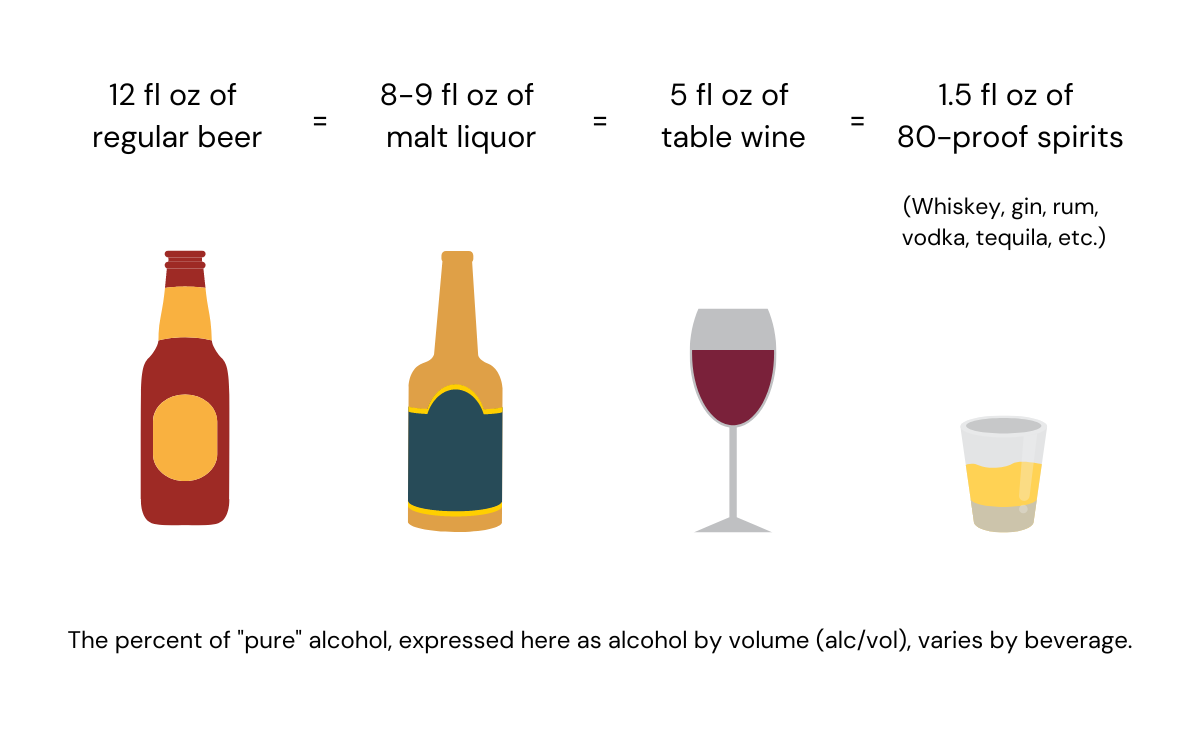Alcoholic beverages don’t typically contain substantial amounts of fat or protein, so we’re really looking at two sources of Calories in alcoholic drinks: the carbohydrate content, and the alcohol (ethanol) itself.
In the United States, a “standard drink” contains roughly 14g of ethanol, although this criterion varies from country to country. An ethanol dose of ~14g can be found in 12 ounces of beer, 5 ounces of wine, or 1.5 ounces of liquor, although these values are very rough estimates. Each gram of ethanol provides 7 Calories, and (unfortunately) not much else.
Acutely consuming large doses of alcohol can impair recovery from exercise, and habitually consuming large doses of alcohol can obviously lead to liver damage, cancer, and other pathologies.
Small doses of alcohol aren’t as deleterious and don’t seem to interfere with fitness-related progress, but they can put our diet in a tight spot by providing plenty of Calories without bringing much value to the table.
If we’re on a fairly Calorie-restricted diet, we need to be mindful of hitting several intake targets, including fiber, protein, essential amino acids, essential fatty acids, and a long list of micronutrients. As such, even small or moderate doses of alcohol can put a little extra strain on the diet if total energy intake is restricted.
When total energy intake is higher, it can be quite easy to fit in small doses of alcohol while achieving target intakes for important nutrients.

In the USA, each of these “standard drink” servings provides around 14g of ethanol (or about 98 kcals worth). However, alcoholic beverages typically have additional calories, predominantly in the form of carbohydrates. There is a wide range of carbohydrate content in various alcoholic beverages (high-gravity beer versus light beer, dry wine versus sweet wine, and so on)
Sugar alcohols are a fairly unique type of alcohol that might find their way into your diet as low-Calorie sweeteners. Some common sugar alcohols include erythritol, isomalt, maltitol, sorbitol, and xylitol.
Sugar alcohols are typically derived from sugars, and they are relatively sweet but typically only contribute about 2.4kcals per gram. As a result, some food companies swap out sugar in favor of sugar alcohols (sometimes in combination with artificial sweeteners) to provide the same amount of sweetness with fewer Calories per serving.
The various sugar alcohols tend to have somewhat distinct properties, which leads to a variety of different sugar alcohols being used in the production of foods with reduced sugars (for example, maltitol provides a better texture to sugar-free and reduced-sugar chocolate products than other sugar alcohols or low-Calorie sweeteners). Another nice characteristic of sugar alcohols is that they’re much better for your teeth than sugar, so using them for sugarless chewing gum is a no-brainer.
This all sounds pretty great, so you might be wondering, what’s the catch? Well, at higher dosages, sugar alcohols are effectively laxatives. While some are worse than others, they can generally induce some pretty unpleasant bloating, flatulence, and diarrhea, and they have created some viral web content as a result. Fortunately, they tend to be quite well tolerated at lower doses, and there’s some degree of habituation by which the gastrointestinal disturbance induced by moderate-to-high doses can wane over time (to an extent).
We recommend swapping alcohol Calories for carbohydrate Calories, which prevents us from skimping on essential fatty acids or essential amino acids when we incorporate alcohol into the diet.
So, if you consume 200 total Calories in the form of alcoholic beverages, you’d remove 50 grams of carbohydrates (carbohydrates have 4 kiloCalories per gram, so dropping 50g of carbohydrates will free up the 200 kiloCalories you’re looking for). MacroFactor makes this very easy by tracking both the grams of alcohol you've consumed and the total Calories from alcohol.
Obviously the major constraints in this scenario pertain to your daily Calorie goal and the magnitude of alcohol consumption. If your diet has plenty of Calories to work with and you’re only hoping to enjoy a single drink, working alcohol into the macro equation is pretty easy. However, if you’re on a very Calorie-restricted diet or you were hoping to consume several beverages in the same day, the math can be pretty unforgiving, and the extra drinks might not be worth the dietary sacrifices required.
Now that you’ve learned how to track alcohol, you might enjoy one of these articles next:
Disable Alcohol Tracking and Display
What are the Blue "Other" Calories on My Nutrition Page?
View Top Food Contributors to Calories, Macros, and Micronutrients for the Day